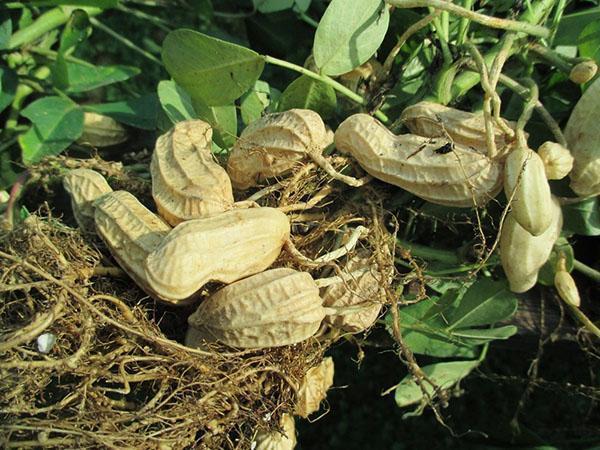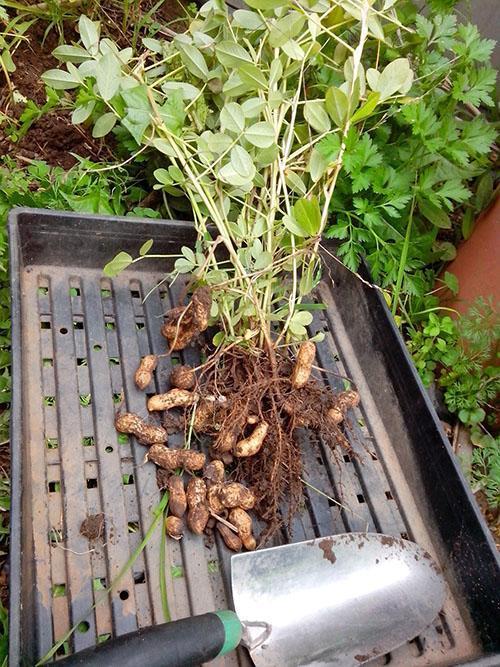Where and how peanuts grow
 Since childhood, everyone is familiar with the taste of fragrant, slightly sweetish earthy nuts, which are added to cakes and chocolate, make snacks based on them and famous, especially in the USA peanut butter... But not everyone knows how peanuts grow.
Since childhood, everyone is familiar with the taste of fragrant, slightly sweetish earthy nuts, which are added to cakes and chocolate, make snacks based on them and famous, especially in the USA peanut butter... But not everyone knows how peanuts grow.
Today, peanuts are the most valuable agricultural crop, accounting for the lion's share of the crop rotation in many countries of Asia and Africa. Groundnut occupies an incredibly important place in the economy and consumption in the United States. But if in the countries where peanuts grow, everyone knows about this culture, then in Russia and European countries the “peanut” is known only as a product. And as a representative of the plant world, he raises a lot of questions.

Read on: how pistachios grow
A nut or a bean: how does a peanut look and grow?
A herbaceous plant with a height of 20 to 70 cm cannot be called a shrub or a fruit tree. And the fruits of the peanuts in legumes are not nuts, but seeds hidden inside the bean pod.
The plant, cultivated for many centuries by the local population of South America, during the development of the continent by Europeans was noticed and immediately appreciated as a promising agricultural crop. Today, millions of hectares are under cultivation all over the world, and the cultivation area is steadily expanding.
 Why are peanuts receiving so much attention? The reason lies in the nutritional value and composition of peanuts, their unpretentiousness and quick yield of the crop.
Why are peanuts receiving so much attention? The reason lies in the nutritional value and composition of peanuts, their unpretentiousness and quick yield of the crop.
The culture grows without any problems where other plants suffer from lack of nutrition and moisture, is not afraid of the sun and can even do without pollinators. In addition, like other annual legumes, peanuts are able not only to feed their soil, but also to enrich it with nitrogen.
Strongly branching herbaceous shrubs or lodging plants have a powerful taproot that grows up to one and a half meters in length. Stems with clearly visible edges are covered with paired leaves, divided into several oval, slightly pointed leaves. Both shoots and leaf plates are covered with soft pile. Flowers with a sail petal bent back and a thin lip are colored yellow.
Until the plant blooms, it is difficult to notice its main feature - the appearance and development of the fruit does not occur above the soil level, but under its surface.
The beans ripening by autumn have a strong, shell-like shell that hides from one to seven oval seeds. This was the reason for the appearance of the famous name of the peanut "peanut".
Peanuts are one of the few plants on Earth that use self-pollinated cleistogamous flowers for reproduction. After the daily flowering and the formation of the ovary, the gynophore shoot rushes to the soil and, burying in it, ensures the underground development of the pod.
 On one plant from June to late autumn, several dozen pods are formed. You can only find them by digging a bush, and you can see how peanuts grow from above, you can only by the ever-increasing number of shoots leaving the ground.
On one plant from June to late autumn, several dozen pods are formed. You can only find them by digging a bush, and you can see how peanuts grow from above, you can only by the ever-increasing number of shoots leaving the ground.
Where do peanuts grow?

Peanuts love warmth, and they need a long dry summer and a similar fall to ripen the beans hidden under the soil. It takes 120-160 days from planting the beans to harvesting. Such conditions are not everywhere.
The original habitat, the birthplace of culture is South America. When the mainland was discovered by Europeans, many interesting plants were sent to the metropolis and other Spanish, Portuguese and British colonies. The Spaniards were the first to try unusual beans, finding them tasty and very useful on long voyages. In the Old World, peanuts also came to taste. As an exotic addition to dishes and a semblance of cocoa beans, it was used in cooking.
To meet the growing demand, the rare and unstable supply of beans from new lands was scarce for the conquerors of the American continent. Therefore, the Portuguese, who appreciated the nutritional properties and yield of peanuts, were interested in how peanuts grow in African conditions.
Peanuts in Africa
 European colonies on the black continent supplied the metropolis with wood, spices, minerals, cotton and slaves. However, due to the poor land, it was very difficult to develop agriculture here. Peanuts helped solve this important problem.
European colonies on the black continent supplied the metropolis with wood, spices, minerals, cotton and slaves. However, due to the poor land, it was very difficult to develop agriculture here. Peanuts helped solve this important problem.
He not only gave the beans the Europeans desired, but also fed the local population, as well as livestock. In some countries, culture has become the main source of income.
Although a lot of time has passed since the conquest of America and the appearance of the peanut in Africa, no one is still surprised why Senegal is called the peanut republic. Since the 17th century, first Portuguese and then French landowners actively plowed free land for peanuts. In the last century, growing over a million tons of beans per year, the country has grown to become the world's largest supplier of groundnuts.
Peanuts in Asia
 Due to the rich composition of peanuts and the presence of valuable vegetable oil used in food for technical purposes, the culture has been recognized in other parts of the world.
Due to the rich composition of peanuts and the presence of valuable vegetable oil used in food for technical purposes, the culture has been recognized in other parts of the world.
Huge plantations of this type of legume are established in Asia. Since the 16th century, the plant has been known in India, a little later crops appeared in the Philippines, Macau and China. It was the Celestial Empire that took the palm from Senegal, where the vast majority of the country's inhabitants still work on processing, planting and harvesting.
American Peanut Success Story
 Since the 19th century, plantations of peanuts or peanuts have appeared on the territory of the North American continent. Having experienced difficulties in feeding the troops of the opposing sides during the Civil War, it was thanks to peanuts that they could support the forces.
Since the 19th century, plantations of peanuts or peanuts have appeared on the territory of the North American continent. Having experienced difficulties in feeding the troops of the opposing sides during the Civil War, it was thanks to peanuts that they could support the forces.
But when the war ended, this leguminous crop was deemed unprofitable due to manual cultivation, and the beans themselves were classified as food for the poor.
Only a happy course of circumstances allowed peanuts in the United States to return to the podium they deserved. Cotton, which most farmers were involved in at the turn of the century, sucked all the juices out of the soil. The number of arable land was reduced, the agrarians were pursued by crop failures and pest attacks. There was an urgent need to take active measures to switch to other crops and maintain agriculture.
 The well-known US scientist D.V. Carver, having studied how much protein, oils, amino acids and other compounds useful for the human body are in peanuts, caught fire with the idea of popularizing this interesting culture. According to the agrochemist, it was impossible to give up the plant, the beans of which are 50% oil and a third of valuable, easily digestible protein. Therefore, thanks to the development of hundreds of food and technical products based on beans, automation of cultivation and a gentle influence on the soil, peanuts from the USA have become a cult plant.
The well-known US scientist D.V. Carver, having studied how much protein, oils, amino acids and other compounds useful for the human body are in peanuts, caught fire with the idea of popularizing this interesting culture. According to the agrochemist, it was impossible to give up the plant, the beans of which are 50% oil and a third of valuable, easily digestible protein. Therefore, thanks to the development of hundreds of food and technical products based on beans, automation of cultivation and a gentle influence on the soil, peanuts from the USA have become a cult plant.
The lion's share of the crop of local beans goes to the production of peanut butter, which is loved by the Americans, industrial and edible oil, as well as to feed livestock, make soap and other needs.
Where do peanuts grow in Russia?
 Today, interest in the plant does not wane. During the Soviet era, peanuts were not paid attention to, and the experience of growing it was undertaken only in the southern republics. Where do peanuts grow in Russia? There are no large plantations of this type of legumes in the country, but enthusiasts of the southern regions, the Black Earth Region, the Southern Urals and even the middle zone are making successful attempts to get a crop of beans in their summer cottages and household plots.
Today, interest in the plant does not wane. During the Soviet era, peanuts were not paid attention to, and the experience of growing it was undertaken only in the southern republics. Where do peanuts grow in Russia? There are no large plantations of this type of legumes in the country, but enthusiasts of the southern regions, the Black Earth Region, the Southern Urals and even the middle zone are making successful attempts to get a crop of beans in their summer cottages and household plots.
Even those who, due to climatic conditions, cannot pamper themselves with peanuts from the garden, should not give up this culture. The original peanut bushes are easy to grow in a pot.
And to learn more about agricultural farming, to understand its features and needs, a video on how peanuts grows will help: